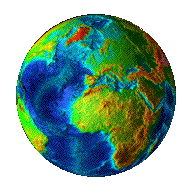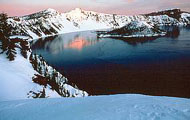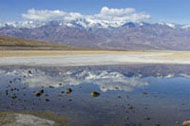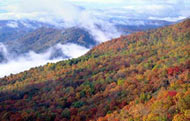|
Earth's
Climate Timeline
Diurnal Cycle Timeline
Driven
by the Earth's spin on its axis,
the diurnal cycle of night and day is a powerful driver of variability
of weather
Sunrise

|
Sunlight hits the surface of the Earth

|
|
Mid
Morning
|
Temperatures rise most quickly during mid morning
|
|
High
Noon
|
Heated
air circulates in bottom 1 km of atmosphere

|
|
Afternoon
|
Temperatures are hottest during the mid afternoon
|
|
Sunset
|
Sunlight stops hitting Earth's surface.
|
|
Evening
|

Temperatures fall most quickly around sunset
as surface and atmosphere radiate heat
|
|
Midnight
|
Lowest
level of atmosphere becomes cooler.
|
|
Middle of the Night
|
Earth,
water surfaces and human communities release stored heat.

|
|
Right
before Dawn
|
Temperatures are coldest around dawn
|
Summary of 1 Year Time Scale
One full orbit
around the sun- the period of a year- serves as a fundamental force of
climate variability as well as a measure of time. The essential cause of
seasonal climate change during the year is the tilt of Earth's axis,
currently 23.5 degree tilt off its axis, which alters the angle of solar
radiation and thus its intensity over the course of the year
Annual Cycle
|
Time of Year
|
Climate Variability |
Solstice
Dec. 21 or 22, shortest day in Northern Hemisphere,
longest in Southern
|
 Northern
Hemisphere tilts away from sun, receiving less direct solar
radiation, while the Southern Hemisphere tilts towards the sun. Northern
Hemisphere tilts away from sun, receiving less direct solar
radiation, while the Southern Hemisphere tilts towards the sun.
Blizzards and ice storms can occur throughout the boreal
(Northern Hemisphere) winter months in higher latitudes and
elevations.
Image of Crater Lake by NPS. |
Spring (Vernal) Equinox
March 20 or 21 in Northern
Hemisphere |
 When
the sun's direct rays pass the equator, the length of day and
night are the same. (Equinox means " equal night"). Without
sufficient spring precipitation, droughts may occur later in the
year as evapotranspiration increases. In regions where winter and
spring precipitation falls as snow, runoff peaks start in the
Spring in the southern regions and progresses northward and upward
in elevation as the season progresses. When
the sun's direct rays pass the equator, the length of day and
night are the same. (Equinox means " equal night"). Without
sufficient spring precipitation, droughts may occur later in the
year as evapotranspiration increases. In regions where winter and
spring precipitation falls as snow, runoff peaks start in the
Spring in the southern regions and progresses northward and upward
in elevation as the season progresses.
Image of New River by NPS
|
Solstice
June 21 or 22, shortest day in the Southern
Hemisphere, longest day in Northern Hemisphere |
 Northern
Hemisphere tilts toward the sun, receiving more intense direct
solar radiation, while the Southern Hemisphere tilts away from the
sun and experiences winter. Northern
Hemisphere tilts toward the sun, receiving more intense direct
solar radiation, while the Southern Hemisphere tilts away from the
sun and experiences winter.
In
regions where winter and spring precipitation falls as snow, there
is often a peak in snow melt runoff around the solstice. Droughts,
flash floods, forest fires and hurricanes are all climate-related
events that usually occur during the summer months and into the
fall.
Wet season during the Indian Monsoon generally begins in June and
goes through September.
Image of Death Valley by NPs
|
|
Autumn
(Autumnal) Equinox
Sept. 22 or 23
in Northern Hemisphere
|
 Sun's
direct rays pass the equator and length of day and night are the
same. The seasonal cooling of the climate during autumn may include
the end of the growing season in some climates. Hurricane activity
may extend well into the Autumn season. Sun's
direct rays pass the equator and length of day and night are the
same. The seasonal cooling of the climate during autumn may include
the end of the growing season in some climates. Hurricane activity
may extend well into the Autumn season.
Image of Black Rock State Park, GA by Tom Wilson, USFS. |
Credit:NASA,NOAA,UCAR
|

